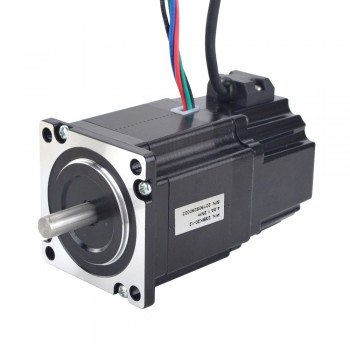1.Basic definition of brake stepper motors
Braking stepper motors are stepper motors with brake functions, mainly used to control brakes and transmission systems. It consists of a stator, a rotor and a brake device. The stator is covered with an electromagnetic coil. When the coil is excited by current, a magnetic field is generated to attract the rotor to step. The brake device is used to control the braking and release of the motor to ensure that the motor can remain in the desired position when it stops.
2.Braking methods of brake stepper motors
1.Short-circuit method: By short-circuiting the two phases of the motor, the motor loses its driving force, thereby achieving the purpose of braking. This method is simple and easy to operate, and does not require additional circuits, but the braking time is long and it is easy to cause the motor temperature to rise, which is not suitable for long-term use.
2.Back electromotive force method: A reverse voltage is added between the two phases of the motor to prevent the motor from rotating. This method has a short braking time and will not cause the motor to overheat, but it requires additional circuits, and the reverse voltage may damage the motor.
3.Current cut-off method: By cutting off the current of the motor, the motor loses its driving force. This method has a short braking time and good braking effect, and will not cause the motor to overheat, but it requires additional circuits, and the timing of current cut-off needs to be mastered accurately.
4.Electromagnetic braking method: The stepper motor itself has a holding torque, which can lock the motor when powered on. If the holding torque of the stepper motor is not large enough, or the holding torque is lost after a power outage, you can consider using a stepper motor with a brake. The brakes of stepper motors are generally spring-type and permanent magnet-type. Permanent magnet brake stepper motors have fast response speed, low noise, and less heat.
3.Advantages of brake stepper motors
1.High-precision stepper control: The brake stepper motor can accurately control the rotation angle and speed of the motor by inputting a specific pulse signal to the motor. This is very important for applications that require precise positioning and fine control, such as printers, CNC machine tools, and automotive braking systems.
2.Low noise and reliability: The brake stepper motor generates low noise during operation, and due to its design and working principle, it has high reliability and can operate stably in various industrial and consumer products.
3.Low power consumption and small size: Braking stepper motors have low power consumption and small size, which makes it easy to embed and apply in most devices.
4.Fast, smooth and accurate braking performance: Braking stepper motors stop the rotor through the friction between the brake disc, brake key and brake pad, and are suitable for occasions that require fast stopping or accurate positioning, such as automation equipment, robots, CNC machine tools and other industrial fields.
5.High efficiency and good low-speed characteristics: Braking stepper motors can quickly accelerate, decelerate and reverse motion, have high efficiency, and perform well at low speeds, ensuring the reliability and long life of the equipment.
6.Used in conjunction with a driver: Braking stepper motors are usually used with a driver, which can provide corresponding current and pulse signals according to the set step and speed parameters, thereby accurately controlling the movement of the motor.
7.Special control functions can be realized: Some advanced braking stepper motors can also realize closed-loop control, by installing encoders and sensors to feedback the actual position and rotation angle of the motor, further improving the control accuracy and stability.

4.Main application scenarios of brake stepper motors
1.Automobile field: Brake stepper motors play an important role in automobile braking systems. By receiving control signals and driving actuators, they can achieve precise deceleration or parking of the car.
2.Two-wheeled vehicles such as bicycles and scooters: The brake systems of these vehicles are usually equipped with brake stepper motors to ensure safety and control speed during driving.
3.Industrial equipment: Many industrial equipment require the use of precise control systems, such as CNC machine tools and printing presses. Brake stepper motors can help realize the automatic control and adjustment functions of equipment.
4.Aerospace field: Brake stepper motors also play an important role in some high-precision instruments and equipment, such as astronomical telescopes and radar systems.
5.Hoisting machinery: In equipment such as cranes and winches, brake stepper motors can brake immediately in the process of lifting or lowering the load, once a fault or abnormality occurs, to prevent heavy objects from falling and ensure the safety of personnel and equipment.
6.Elevator system: Provide reliable braking protection for the up and down movement of the elevator, ensure that the elevator is accurately in place when it stops, and quickly brake in an emergency to avoid accidents.
7.Automated production line: On an automated production line, when a link fails or an emergency shutdown is required, the brake stepper motor can quickly stop the operation of related equipment to prevent product damage, equipment collision, etc., and reduce production losses.
8.Stage machinery: In stage lifting, translation and other equipment, the brake stepper motor can ensure the safety of actors and equipment and avoid accidents.
